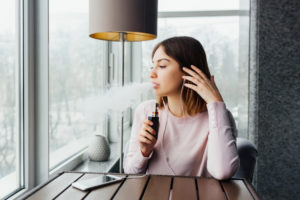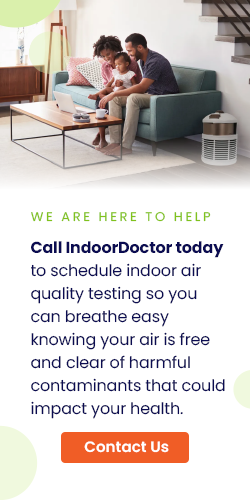On the surface, e-cigarettes, vaping, seem like a viable option to combating traditional cigarettes. Instead of emitting smoke, e-cigarettes emit a vapor that has been touted as a way for smokers to reduce or quit their habit. Vape stores even tout their product as being “safe”, or at the very least, safer than smoking cigarettes.

But is it really and truly safe? The studies on the impact of indoor air quality would say no.
What Exactly are E-Cigarettes?
In case you’re not familiar with the term, e-cigarettes are smoking devices that use cartridges filled with flavored liquid rather than tobacco leaves. Instead of lighting a rolled-up cigarette to smoke, the user will turn on their e-cigarette to heat the liquid in the cartridge that produces a vapor rather than smoke.
Like traditional cigarettes, these solutions typically contain nicotine, the addictive chemical in cigarettes.
Though manufacturers and retail stores have tried to disassociate e-cigarettes from their traditional counterparts, hundreds of municipalities have banned them from areas that are labeled as “smoke-free”, and research makes it easy to see why.
Health Issues Caused By Living Near an Airport
What Does Vaping Release into the Air?
Cigarettes have endured heat from health experts for many reasons, particularly in the harmful secondhand smoke they create. With e-cigarettes, there is no secondhand smoke, per se, with smoke being replaced by vapor. But contrary to common belief, this “vapor” isn’t just harmless water vapor.
Rather, the “vapor” is comprised of nicotine and other harmful toxins that are known to cause cancer. Studies show the components of the vapor have detected ultrafine particles that are more concentrated than the same particles found in cigarette smoke.
Among these particles in secondhand vapor are Benzene, Formaldehyde, Isoprene, Nicotine, N-Nitrosonornicotine, Toluene, and Propylene Glycol.
Some experts may be quick to say that propylene glycol, in particular, has been approved by the FDA in some products, but the vaporization of this compound is not approved. In fact, some studies show that heating this compound changes its chemical makeup and creates propylene oxide, which is a known carcinogen.
These particles can worsen respiratory ailments like asthma, and even constrict arteries that could trigger a heart attack.
Other studies have shown that vaping in large quantities can pose a negative impact on air quality. It’s important to recognize that excessive or prolonged exposure to vaping could have a serious impact on your air quality.
Bottom Line: Does Vaping Negatively Impact Indoor Air Quality?
The short answer as to whether vaping will impact indoor air quality is yes. If you vape or allow other people to vape in your home, over time it could pose a risk to your air ducts, which does impact your air quality. Vaping isn’t harmless, as manufacturers would want you to believe, and you should do everything you can to limit your exposure.
Could your indoor air quality be contaminated due to vaping activity? Call Indoor Doctor today to schedule indoor air quality testing so you can breathe easy knowing your air is free and clear of harmful contaminants that could impact your health.
https://www.indoordoctor.com/blog/the-invisible-dangers-of-ozone-machines-do-they-make-your-air-quality-worse/
[/et_pb_text][/et_pb_column][/et_pb_row][/et_pb_section]






